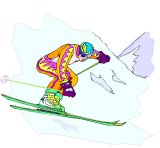
Worksheets and No Prep Teaching Resources
Reading Comprehension Worksheets
 Worksheets and No Prep Teaching Resources Reading Comprehension Worksheets |
|
| edHelper's suggested reading level: | grades 4 to 5 | |
| Flesch-Kincaid grade level: | 2.61 |
|
Olympic Alpine Skiing
By Phyllis Naegeli |

|
 1 Why would anyone want to ski down a mountain? First, you have to put on hard, rigid boots. Then you secure the boots to a long pair of thin sticks. You get on a chair that takes you to the top of a mountain. It's cold up there! Now you have to get down. To do this, you point your skis towards the bottom of the mountain. Alpine skiing has been called "the fastest non-motorized (land) sport." That's because you can go pretty fast! Downhill skiers can go up to sixty miles per hour. Zoom!
1 Why would anyone want to ski down a mountain? First, you have to put on hard, rigid boots. Then you secure the boots to a long pair of thin sticks. You get on a chair that takes you to the top of a mountain. It's cold up there! Now you have to get down. To do this, you point your skis towards the bottom of the mountain. Alpine skiing has been called "the fastest non-motorized (land) sport." That's because you can go pretty fast! Downhill skiers can go up to sixty miles per hour. Zoom! |
Create Weekly Reading Books
Prepare for an entire week at once! |
| Leave your feedback on Olympic Alpine Skiing (use this link if you found an error in the story) |